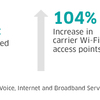By: Andreas Lemke, Alcatel-Lucent Sr. Marketing Manager – Cloud
“GM factories reduce production in aftermath of Japan earthquake 2011”, “Hard disk shortage due to Thailand flooding 2012“, “Drug shortages continue to vex doctors”, “China factory fire sends memory chip prices to three-year high (2013)”. Industrial supply chains are becoming increasingly tenuous as they are thinned out and stretched across the globe. Raw materials are available from fewer and fewer specialized suppliers and warehouses are eliminated for just-in-time production. Small, local incidents affect the supply of goods on a global scale.
In the IT industry we are seeing a similar trend. Enterprises are moving their applications and data to the cloud, but this cloud is often highly centralized and not as resilient, free flowing, or efficient as one might think. Amazon Web Services, the largest cloud provider in the world, is serving their global customers from no more than two handfuls of locations. Netflix and other companies have experienced major outages due to single failures in the cloud they used.
So what does this mean for NFV?
Traditionally, telco networks have been highly distributed with thousands of central offices spread across the country. But today’s high-speed fiber connections and powerful server farms give service providers the option to re-architect and potentially centralize their network. Clearly, highly centralized deployments are cheaper to manage than many small, scattered locations. But what works for many Web and Internet services is not always the best choice for carrier grade services such as mobile voice, video and data for the enterprise.
Telefonica and Alcatel-Lucent have analyzed factors, such as latency, high availability, and security, that determine geographical placement decisions for different applications in telco networks. NFV and cloud technologies allow service providers to choose the best locations depending on the needs of the applications, and avoid the kind of dramatic effects that we are seeing in other industries. At the end of the day this is a supply chain and logistics challenge where ensuring goods are available to users whenever they want them, the supplier with a short delivery chain, i.e., a distributed network, tends to be the most successful.
To manage the cost of a distributed architecture, service providers need an NFV and SDN platform that automates infrastructure and application lifecycle and provides an aggregate view of the distributed NFV resources. Since its launch in 2012, Alcatel-Lucent’s CloudBand NFV Platform, together with the Nuage Networks SDN Virtualized Services Platform (VSP), has been designed for this type of flexible, distributed NFV network architecture.
For more details, read the Telefonica/Alcatel-Lucent white paper “Why distribution matters in NFV”. Related postings include:











